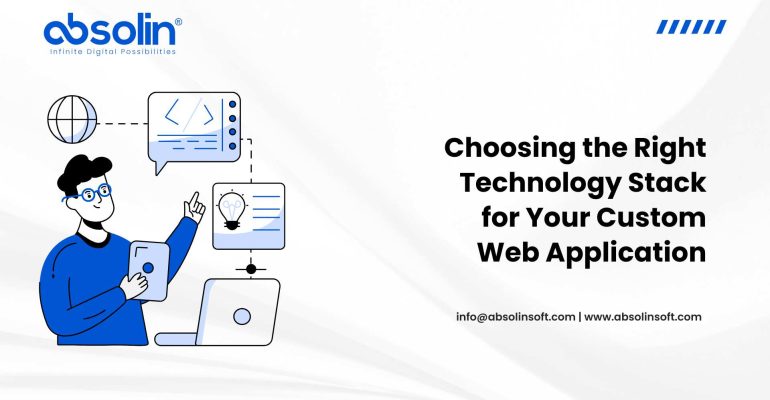Choosing the Right Technology Stack for Your Custom Web Application
Imagine you’re building your dream house. You’ve picked the perfect location, envisioned the layout, chosen the decor but the foundation? That’s the part no one sees, yet it holds everything together. Choose the wrong material or cut corners, and you’ll find yourself fixing cracks when you should be enjoying the view.
In the world of web development, your technology stack is that foundation. It dictates how well your app performs, how easily it scales, how secure it is, how fast you can launch and even how expensive it is to maintain over time.
Choosing the right tech stack is not just a technical decision – it’s a strategic one. Get it right, and your application becomes agile, scalable, and future-proof. Get it wrong, and you’ll face performance bottlenecks, ballooning costs, and constant patchwork.
So, how do you pick the right tools, frameworks, and languages from a sea of options? Let’s break it down.
What Is a Technology Stack?
A technology stack is the combination of programming languages, frameworks, libraries, databases, and tools used to build and run a web application. It’s typically divided into two main layers:
🔹 Frontend (Client-Side)
This is what users interact with – the visible, clickable parts of your app. Technologies include:
- HTML, CSS, JavaScript
- Frameworks: React, Angular, Vue.js, Svelte
- UI Libraries: Bootstrap, Tailwind, Material UI
🔹 Backend (Server-Side)
This is the behind-the-scenes engine that processes requests, communicates with databases, and handles business logic.
- Programming Languages: Node.js, Python, Ruby, PHP, Java, .NET
- Frameworks: Express.js, Django, Flask, Laravel, Spring
- Databases: PostgreSQL, MySQL, MongoDB, Redis, Firebase
Many also include:
- DevOps & Infrastructure: Docker, Kubernetes, AWS, Azure, GitHub Actions
- APIs & Integrations: REST, GraphQL, WebSockets
- Security Tools, CI/CD Pipelines, and Analytics SDKs
Why the Right Tech Stack Matters
Choosing your tech stack affects more than just the development phase. It impacts:
- 🕒 Time to market
- 📈 Scalability as your user base grows
- 💵 Cost of development and maintenance
- 🔐 Security and compliance
- 👥 Developer availability and hiring
- 🧩 Integration with third-party services
- 🚀 Performance and user experience
It’s like choosing materials for your building—metal, wood, concrete. Each has its pros and cons depending on the environment, budget, and goals.
Key Factors to Consider When Choosing a Technology Stack
1. Project Requirements and Complexity
Ask yourself:
- Are you building a small MVP or a full-scale enterprise platform?
- Does it require real-time updates (e.g., chat, trading apps)?
- Is it data-heavy, user-intensive, or transaction-based?
Example:
For a real-time app, consider Node.js + Socket.io. For a data-heavy dashboard, Python + Django + React might be better.
2. Team Expertise and Developer Availability
Using a language your developers already know can cut learning curves and speed up delivery.
Also, consider how easy it is to hire new developers for your stack.
Hot demand = bigger talent pool, but potentially higher salary expectations.
3. Performance and Scalability
Some stacks handle large user bases and complex computations better.
- Need low-latency, high-performance? Consider Go or Node.js.
- Need high-concurrency? Elixir or Erlang could be ideal.
- Horizontal scalability? Think microservices with Docker & Kubernetes.
4. Time to Market
Using mature frameworks and third-party libraries can accelerate development.
If speed is essential, choose tools with strong community support, plugins, and documentation.
Rapid MVP? Try Firebase + React, or Ruby on Rails.
5. Security Requirements
Different industries demand different levels of security and compliance.
- Healthcare? Think HIPAA-ready stacks like Django with advanced encryption.
- Finance? Opt for robust, type-safe languages like Java or .NET.
Also factor in how easily your stack supports:
- Role-based access control
- OAuth, JWT
- Data encryption
- Audit trails
6. Long-Term Maintenance and Support
The more exotic the stack, the harder it may be to maintain.
Choose tools that are actively supported, well-documented, and backed by large communities.
Avoid frameworks that are too new or no longer maintained—unless you’re willing to take that risk.
7. Integration Capabilities
Will your app connect to CRMs, payment gateways, ERPs, or third-party APIs?
Make sure your backend language has SDKs or support for all the platforms you need to work with.
Popular Tech Stack Combinations
Here are a few widely adopted combinations, with their typical use cases:
| Stack | Components | Best For |
| MERN | MongoDB, Express.js, React, Node.js | Real-time apps, startups |
| MEAN | MongoDB, Express.js, Angular, Node.js | Enterprise-grade apps |
| LAMP | Linux, Apache, MySQL, PHP | Legacy apps, cost-conscious builds |
| Django + React | Python (Django), React, PostgreSQL | Analytics dashboards, secure apps |
| Ruby on Rails | Rails, PostgreSQL, Turbolinks | MVPs, marketplaces |
| .NET + Blazor | C#, ASP.NET Core, SQL Server | Enterprise and corporate portals |
| Jamstack | JavaScript, APIs, Markup (e.g., Gatsby, Netlify) | Static sites, performance-focused apps |
Tech Stack Pitfalls to Avoid
- ❌ Over-engineering: Don’t use microservices for a basic to-do list app.
- ❌ Chasing trends: Hype doesn’t equal suitability for your project.
- ❌ Ignoring DevOps: CI/CD, logging, and deployment automation matter just as much.
- ❌ Tight coupling: Avoid stacks that are too interdependent—makes it harder to pivot later.
- ❌ Neglecting mobile: If mobile is key, choose frontend frameworks that work well with React Native or Flutter.
Steps to Choose the Right Tech Stack
- Define the product scope and key features.
- Analyze the technical requirements.
- Assess your team’s skill set (or hire accordingly).
- Identify third-party services and integration needs.
- Shortlist stacks based on scalability, security, and performance.
- Run small prototypes or MVPs to test assumptions.
Conclusion: The Right Stack Powers the Right Product
The technology stack you choose will shape your app’s capabilities, your team’s productivity, your budget—and ultimately, your product’s success. It’s not about picking the trendiest tools or following what tech giants use. It’s about finding the stack that aligns with your product goals, team expertise, timeline, and future vision.
So, before you lay the first digital brick, ask yourself:
- What are we building, really?
- Who are we building it for?
- What will this need to become in 1, 3, or 5 years?
Because much like building a house, the right foundation isn’t just about stability—it’s about building something that lasts, grows, and adapts with you.
Need help choosing the right stack for your project? Absolin can guide you through a personalized tech stack evaluation tailored to your team, goals, and budget!



